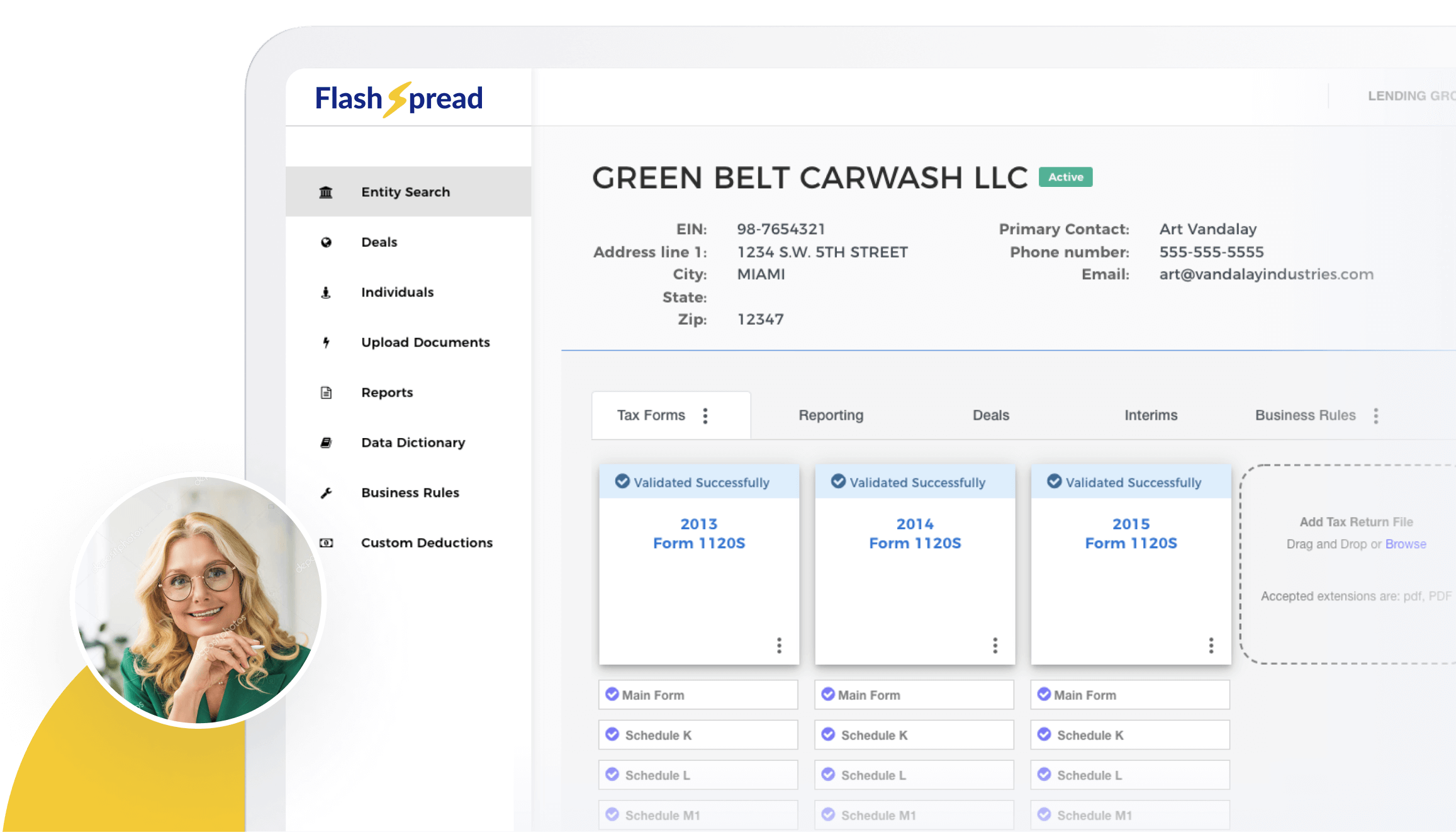Credit analysis is undergoing one of the most significant shifts in decades. For years, underwriters and analysts have been asked to do more with less: more volume, more complexity, more compliance, all while keeping cycle times tight and error rates low. Manual financial spreading simply can’t keep pace with the demands of modern commercial lending.
Automation has already begun reshaping workflows, especially in the spreading stage. But the next wave is here: AI-enhanced automation that improves accuracy, accelerates turnaround times, and gives analysts cleaner, more reliable data to work from.
Contrary to the popular narrative, this isn’t about AI replacing credit analysts. It’s about creating a future where analysts operate with better data, stronger consistency, and faster insights, while keeping judgment, interpretation, and borrower relationships firmly in human hands.
Key Insights at a Glance
- AI-assisted automation is accelerating credit workflows, not replacing analysts.
- Early-stage data extraction and spreading see the biggest accuracy and speed gains.
- Analysts gain more time for judgment-based evaluation, portfolio analysis, and borrower engagement.
- Clean, structured data reduces risk and improves consistency across teams.
- The future of credit analysis is a hybrid model: machine speed + human insight.
Table of Contents
The Real Problem: Credit Teams Are Drowning in Data, Not Decisions
Most commercial lenders agree on the same operational pain points:
- Manual spreading consumes hours per loan.
- Data accuracy varies significantly across analysts.
- Turnaround times spike when loan volume increases.
- Audit and compliance reviews are slow and inconsistent.
- Unstructured documents add complexity to every file.
Analysts were hired for their expertise, not for number transcription. Yet manual data entry remains a major bottleneck, especially when dealing with multi-entity tax packages or inconsistent borrower documents.
As loan demand fluctuates and regulatory expectations increase, the gap between what teams should be spending time on (credit insight, risk mitigation, portfolio strategy) and what they actually spend time on (PDF flipping, manual reconciliation, duplicate data entry) is widening. The pressure is mounting: borrowers expect faster answers, leadership expects improved efficiency ratios, and regulators expect transparent, accurate data. This is why automation, especially AI-enhanced automation, is quickly becoming a strategic necessity.
How AI-Enhanced Automation Improves Credit Analysis
1. Faster, More Accurate Data Extraction
OCR has long been the backbone of spreading automation. But OCR alone struggles with:
- inconsistent tax return formats
- lower-quality scans
- handwritten notes
- multi-entity filings
Machine learning fills these gaps by learning patterns across thousands of real-world documents thus improving interpretation, classification, and extraction accuracy. The result: Analysts spend less time correcting inputs and more time analyzing credit quality.
2. Standardization Across Analysts and Teams
Even experienced analysts spread financials differently, leading to:
- inconsistent ratio logic
- misclassifications
- variations in add-backs or adjustments
- unpredictable audit results
AI-enhanced automation applies the same structure, formulas, and categorization across every spread, eliminating analyst-by-analyst variability.
Standardization also improves fairness and transparency. When every borrower is evaluated using the same logic, credit teams can defend decisions more confidently and respond to auditors more quickly. It also improves internal collaboration, such as credit analysts, underwriters, and portfolio managers all work from the same structured dataset, reducing friction and miscommunication across departments.
3. Stronger Risk Detection Through Clean Inputs
Errors in the spreading stage ripple through the entire credit file. Bad inputs create bad outcomes. AI-assisted systems help:
- reduce mis-keyed values
- classify line items more consistently
- surface anomalies earlier
- maintain consistency across multiple years of financials
When analysts start with cleaner data, they can focus on what matters: creditworthiness, trends, and long-term performance.
4. Shorter Cycle Times Without Sacrificing Quality
Competitive pressure continues to rise. Borrowers expect speed, and lenders who respond quickly win more deals. AI-enhanced automation helps compress spreading time from hours to minutes, providing:
- faster review cycles
- more accurate credit memos
- higher throughput without adding staff
- measurable improvements in efficiency ratios
Reduced cycle times also improve borrower relationships, especially for small businesses that rely on fast credit decisions to manage cash flow. Commercial lenders know timing can determine whether a deal closes or walks to a competitor. With cleaner financials prepared sooner, loan officers can keep momentum with borrowers, and analysts can avoid last-minute bottlenecks during peak volume seasons.

Where Risk Still Shows Up, Even With Automation
Automation reduces manual workload, but it doesn’t eliminate the need for human oversight.
1. Complex Global Cash Flow Interpretations
Multi-entity structures, affiliate interactions, and seasonal cash flows still require human judgment.
Subscribe to BeSmartee 's Digital Mortgage Blog to receive:
- Mortgage Industry Insights
- Security & Compliance Updates
- Q&A's Featuring Mortgage & Technology Experts
2. Nuanced Credit Decisions
Borrower character, repayment behavior, collateral reliability, and forward-looking risks demand human interpretation.
3. Regulatory Expectations
Regulators require documented human judgment and transparent logic behind each credit decision.
4. Exceptions and Edge Cases
AI models excel at patterns but edge cases often fall outside those patterns. Humans must step in.
How FlashSpread Supports This Future
FlashSpread was built for commercial lending teams that manage high volumes of tax returns and financial statements and need clean, reliable data quickly.
FlashSpread offers:
- OCR + machine learning extraction for structured and unstructured financial documents
- Automated spreading across commercial and SBA workflows
- Minutes-fast processing, typically reducing spreading time from ~3 hours to ~5 minutes
- Standardized spreads and ratios for consistent evaluations
- Global debt service analysis and multi-year comparisons
- Audit-ready outputs that support internal review and regulatory expectations
- Integrations with leading LOS platforms, enabling seamless workflow handoffs
- Evolving AI enhancements, improving classification, pattern recognition, and anomaly detection over time
FlashSpread also supports a growing range of document types, including complex tax returns, supporting schedules, and in-beta business financial statements. This makes it especially valuable for lenders dealing with multi-entity borrowers or inconsistent documentation. By automating the most time-consuming parts of financial prep, FlashSpread enables analysts to focus on judgment, risk evaluation, and borrower communication. It doesn’t replace human insight; it amplifies it, giving teams the clean data foundation they need to move faster and make stronger credit decisions.

Q&A: Common Questions About AI-Enhanced Credit Analysis
Q. Will AI replace credit analysts?
A. No. AI improves data accuracy and speed, but analysts remain responsible for judgment-based decisions and regulatory oversight.
Q. Can AI-enhanced tools support multi-entity or complex tax filings?
A. Many modern spreading tools can organize multi-entity tax data into a unified structure, reducing manual reconciliation and giving analysts a cleaner starting point.
Q. How quickly can lenders see efficiency gains?
A. Most teams experience faster turnaround times and reduced rework within the first few months of adopting automated spreading workflows.
Roundup
AI is reshaping credit analysis, but its real value is in strengthening, not replacing human judgment. By automating data extraction and spreading, lenders gain cleaner inputs, faster turnaround times, and more consistent financial analysis across teams. This reduces manual workload and gives analysts more time to focus on evaluating credit quality instead of preparing data.
The strongest lending operations will embrace this balance: automation for speed and accuracy, and humans for interpretation and decision-making. With reliable, structured data at the start of every file, lenders can make faster, more confident credit calls and deliver a better borrower experience in any market.
Curious how AI can elevate your credit team without adding complexity? Take a closer look at today’s smarter spreading workflow.




